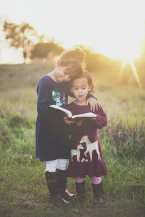Empathy: Guiding Children Through Emotions

Whining in Kids: Insights on Roots and Empathetic Responses
When it comes to children’s behavior, particularly their whining, many of us might feel a mix of irritation and bewilderment. It’s not always easy to pinpoint the exact cause or know how to respond. Remember those moments when you’d hear that distinct whiny tone, and all your instincts might’ve been to dismiss or reprimand? Well, let’s dive deeper into this topic.
Whining, at its core, is often a child’s unique way of communicating distress. Much like the way we, as adults, might show our frustrations or stress, children use whining as an outlet. It’s a signal. It tells us, “Hey, something’s bothering me.” It might be fatigue, hunger, or a deeper emotional need. It’s a call for attention, for understanding, and most importantly, for empathy.
What’s fascinating, though, is that when children resort to whining, they’re actually showing some self-restraint. Yes, you heard that right! Instead of a full-blown tantrum or aggressive behavior, they’re choosing to communicate, even if it’s not in the tone we’d prefer. In a sense, that’s commendable.
So, the next time you encounter that all-too-familiar whine, take a deep breath. See it as an opportunity to connect, understand, and respond with kindness and patience. By doing so, we’re not only addressing the immediate issue but also teaching them the value of empathy and effective communication. Let’s journey together in understanding our kids better and fostering a deeper bond with them.
Misunderstanding Whining: Breaking Myths and Celebrating Small Wins
Often, in the bustling journey of parenting, we encounter behaviors that leave us a tad perplexed. Whining is surely one of them. It’s easy to view it as a bothersome habit, a tone we’d rather not hear. But, have you ever stopped to think about what lies beneath those high-pitched complaints?
First and foremost, let’s debunk a common misconception: whining is not just a means to annoy or manipulate. In fact, it’s a child’s way of conveying something. They’re trying to communicate, even if it’s not in the most melodious manner. Now, here’s the interesting part. When children whine, they are, in many ways, showing a level of self-control. Think about it. They could be throwing a fit, stomping their feet, or even resorting to aggressive behaviors. Instead, they’re choosing a middle ground: they’re using their words, albeit in a whiny tone.
So, if we shift our perspective a bit, we can actually see whining as a win. It’s a bridge, a step before the escalation. As parents or caregivers, recognizing this can equip us to respond more effectively. Instead of dismissing or getting irritated, we can see it as a cue, an invitation to connect, understand, and guide.
Navigating the world of parenting is filled with these little nuances. By understanding the why behind behaviors, we can create a more harmonious and empathetic environment for our little ones. So, the next time that familiar whine rings in your ears, remember: it’s a small victory in the vast landscape of child development. Celebrate it, respond to it, and watch your connection with your child grow.
Proactive Approaches: Addressing Whining with Care and Understanding
As caregivers, our journey often finds us at crossroads, figuring out the best way to navigate a child’s emotional landscape. Whining is one such juncture where understanding meets action. But before we jump into addressing the act, it’s essential to have the right tools at our disposal, tools that preempt and tackle whining with compassion.
Imagine this: your child has had a long day, and out of the blue, that familiar whine begins. Instead of feeling overwhelmed or frustrated, consider viewing it as a beacon, signaling that your child needs something. It might be as basic as hunger or fatigue, or perhaps something deeper, an unexpressed emotion or need.
Now, instead of brushing it off or meeting it with annoyance, we can employ a set of constructive strategies:
- Connection: The power of undivided attention cannot be overstated. Often, children whine because they feel unheard or overlooked. A mere ten minutes of your undivided attention can work wonders.
- Physical Needs: Sometimes, the solution is as simple as addressing a basic physical need. Perhaps they’re hungry, tired, or just need a trip to the restroom.
- Empathy: This might be the most powerful tool in our arsenal. Responding to whining with empathy, acknowledging their feelings, and showing genuine concern can be the bridge to deeper understanding.
- Setting Boundaries: On occasions, it might be worthwhile to set a gentle limit. This doesn’t mean being dismissive but rather guiding them towards a more effective way of expressing themselves.
- Model Behavior: It’s essential for us to lead by example. If we want our children to communicate calmly and effectively, we should ensure we’re showcasing those behaviors ourselves.
Remember, each child is unique, and there’s no one-size-fits-all approach. However, with patience, understanding, and the right tools, we can turn moments of whining into opportunities for growth, connection, and deepened understanding. Let’s embark on this journey together, meeting challenges with solutions, and fostering an environment of compassion and growth.
Mirroring Compassion: Guiding Children Through Emotional Challenges
In our journey of parenthood, it’s quite natural to encounter moments when our child’s emotions trigger a spectrum of feelings within us. But herein lies the essence: how we respond to these triggers can shape the emotional development of our young ones.
Imagine a scenario where your dear one comes home overwhelmed, using a tone that might seem annoying or even aggressive. Our immediate reaction, quite understandably, might be to shut down or dismiss their feelings based on their delivery. However, isn’t it a tad unfair? Consider the times when, as adults, we’ve been brushed off due to our emotional states. Statements like “Oh, you’re just being emotional” or “It must be that time of the month” can resonate with many of us, emphasizing how diminishing it feels to have our sentiments dismissed.
In a similar vein, our children’s whines and emotional outbursts are pleas for understanding. Dismissing them by saying, “Use your words” or “Stop whining” might be a temporary fix, but it won’t bridge the emotional gap. It’s like telling a colleague or a friend, “I won’t talk to you if you’re speaking in that tone.” Such an approach, rather than being constructive, only adds to the distance.
Embracing empathy paves the path for healthier emotional communication. By mirroring compassion and understanding, we offer our children an invaluable lesson in self-expression and self-regulation. Instead of reacting to their emotional states, let’s respond by:
- Listening Actively: Giving them our full attention to genuinely comprehend their feelings.
- Validating Their Feelings: Acknowledging their emotions without judgment or belittlement.
- Guiding Calmly: If they’re lost in a sea of emotions, be their anchor. Guide them gently towards expressing themselves effectively.
In essence, by modeling empathy, we not only enhance our bond with our children but also equip them with the tools to face the world with understanding and compassion. Through our actions, let’s craft a nurturing space where feelings are recognized, respected, and responded to with love.
Conclusion
Our journey through parenthood, while filled with unparalleled joys, also comes intertwined with challenges. Among these, navigating the intricate tapestry of our child’s emotions and responses stands out. It’s not merely about reacting to those emotional tugs, but about actively seeking to understand, validate, and guide. By embodying empathy, we set a precedence. We teach our children that emotions, no matter how tumultuous, are valid and that it’s okay to seek solace, understanding, and guidance. This not only deepens our bond with them but also equips them with a compassionate lens through which they can view the world. In the grand tapestry of life, such lessons, sown with love and patience, blossom into the threads of resilience, empathy, and understanding. Let’s cherish each moment, learn from every challenge, and continually strive to be the beacon of love and guidance our children seek.
















